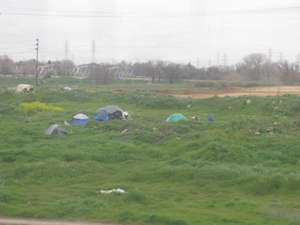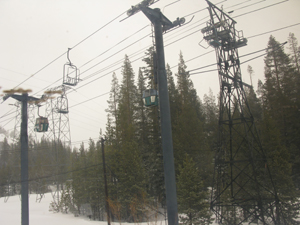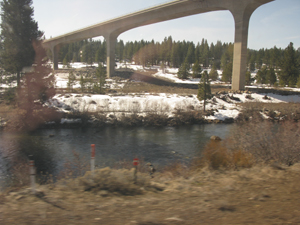 Looking back down the track
Each time we experiment with public transportation, we seem to enjoy it more. We have logged enough miles by
truck during the past decade to qualify as experts in private transportation, and we certainly enjoyed that,
but although we have had terrific train trips in Europe we are only beginning to become familiar with train
travel here at home. The high peaks of the Sierra Nevada still have snow, even though we are half-way
through March. What a great time, we decided, to take a train ride!
Looking back down the track
Each time we experiment with public transportation, we seem to enjoy it more. We have logged enough miles by
truck during the past decade to qualify as experts in private transportation, and we certainly enjoyed that,
but although we have had terrific train trips in Europe we are only beginning to become familiar with train
travel here at home. The high peaks of the Sierra Nevada still have snow, even though we are half-way
through March. What a great time, we decided, to take a train ride!
We immediately discovered that train travel involves us with real people, with real quirks,
unlike airline travel. The Amtrak California Zephyr travels from Emeryville (well, San Francisco, except that
one travels by Amtrak bus from San Francisco to the Emeryville station) all the way across the country to Chicago,
with connecting service to New
 Homeless tents near Sacramento
York. A trip to Reno, Nevada was small potatoes for this train, even though at least two dozen passengers
embarked with us, directed to the special car at the end of the train, which would be dropped after we disembarked.
Homeless tents near Sacramento
York. A trip to Reno, Nevada was small potatoes for this train, even though at least two dozen passengers
embarked with us, directed to the special car at the end of the train, which would be dropped after we disembarked.
The conductor, a down-to-earth redheaded woman, shooed us into the car, checked our tickets, hung a tag above our
seats, and hollered out instructions familiar to all travelers, involving NO FEET ON SEATS, READ THE EMERGENCY
INSTRUCTIONS, THE DINING CAR OPENS AT NOON and so on. Although our tickets were for reserved coach seats, the
reservation does not extend to specific seats, nor, often, even to specific cars, a situation which caused a
 Passing through a town
minor kerfuffle when a group boarded a few stops later and wanted SATISFACTION. But the cars are spacious, more comfortable
than the coaches we found in Europe, and the train is nearly silent, in stark contrast to the continual high-pitched
engine noise of an airplane. The coaches are two levels, but the lower level is generally used for handicapped
passengers, luggage, service areas and washrooms; we liked sitting up high to watch the scenery. We met a friendly couple from Watsonville, California,
who are experienced train riders, having made this journey several times before, but who prefer the trip to Seattle,
and who are already planning their next ride, to Santa Barbara.
Passing through a town
minor kerfuffle when a group boarded a few stops later and wanted SATISFACTION. But the cars are spacious, more comfortable
than the coaches we found in Europe, and the train is nearly silent, in stark contrast to the continual high-pitched
engine noise of an airplane. The coaches are two levels, but the lower level is generally used for handicapped
passengers, luggage, service areas and washrooms; we liked sitting up high to watch the scenery. We met a friendly couple from Watsonville, California,
who are experienced train riders, having made this journey several times before, but who prefer the trip to Seattle,
and who are already planning their next ride, to Santa Barbara.
Our route took us past the alleys and back yards of Berkeley and Oakland, along the edge of San Pablo Bay, its muddy
 Ski lifts near Donner Summit
flats visible at low tide, near the oil refineries and holding tanks of Martinez and Richmond. We saw homeless encampments near the train tracks. The clean pup tents made us think of families newly foreclosed. Soon we were out of the metropolitan sprawl
and beginning our journey through towns and cities first settled during Gold Rush days. After Sacramento, we began
the ascent into the mountains.
Ski lifts near Donner Summit
flats visible at low tide, near the oil refineries and holding tanks of Martinez and Richmond. We saw homeless encampments near the train tracks. The clean pup tents made us think of families newly foreclosed. Soon we were out of the metropolitan sprawl
and beginning our journey through towns and cities first settled during Gold Rush days. After Sacramento, we began
the ascent into the mountains.
Our weather going east was cloudy with light rain showers. The rice fields near Sacramento bent over; fruit trees in the
orchards were in lavish bloom. Before we had achieved much altitude we began to see patches of snow on the ground,
first in canyons and at the base of large trees, then more widely visible, until by the time we reached Donner summit
the snow was deep and crisp and uneven. We passed ski lifts with a few end-of-season skiers.
 Our train
Walking through the train was pretty easy, though we had to hold on to the backs of seats for balance. At the center of the train, a lounge/observation car has huge windows curving to the roof and the stairway to the snack bar downstairs.
We wanted to try the dining car, so when it opened at noon we were among the first to be seated. One end of the
dining car served mostly the passengers from the sleeping cars, and on our half we joined other coach passengers.
We were seated in groups of four; our table partners were two law students on a Spring break ski trip. They had their expenses
paid by an extreme skiing e-zine; one was the writer, the other the photographer. They hoped for snow and sunshine.
We had menus (mostly sandwiches, plus one hot dish, and mac and cheese or hot dogs for children); the steward
announced the menu options to everyone seated in the dining car. The food was prepared on the lower level and sent up by
Our train
Walking through the train was pretty easy, though we had to hold on to the backs of seats for balance. At the center of the train, a lounge/observation car has huge windows curving to the roof and the stairway to the snack bar downstairs.
We wanted to try the dining car, so when it opened at noon we were among the first to be seated. One end of the
dining car served mostly the passengers from the sleeping cars, and on our half we joined other coach passengers.
We were seated in groups of four; our table partners were two law students on a Spring break ski trip. They had their expenses
paid by an extreme skiing e-zine; one was the writer, the other the photographer. They hoped for snow and sunshine.
We had menus (mostly sandwiches, plus one hot dish, and mac and cheese or hot dogs for children); the steward
announced the menu options to everyone seated in the dining car. The food was prepared on the lower level and sent up by
 The Truckee River
dumbwaiter. With at
least two dozen tables and only two stewards, lunch proceded at a rather stately pace, giving us plenty of time
to chat with our seatmates and enjoy the ever deeper snow. Our meal (Bob's chicken stew, pastrami sandwiches for
the rest of our table, soft drinks and ice cream) allowed us to stay in the dining car for about one and a half hours.
We recommend getting to the dining car in time for the first seating!
The Truckee River
dumbwaiter. With at
least two dozen tables and only two stewards, lunch proceded at a rather stately pace, giving us plenty of time
to chat with our seatmates and enjoy the ever deeper snow. Our meal (Bob's chicken stew, pastrami sandwiches for
the rest of our table, soft drinks and ice cream) allowed us to stay in the dining car for about one and a half hours.
We recommend getting to the dining car in time for the first seating!
Arrival in Reno found us only a couple of blocks from our hotel. Unlike Las Vegas, which is an extension of Southern
California, Reno is filled with cowboys and other westerners, and
makes us feel as though we had found ourselves in the Old West a century ago.
 Inside our Amtrak coach
Two days later, we retraced our steps to the station and boarded the train for our return trip. This time, instead
of beginning its journey, Train #5 was two days out of Chicago, and some of the passengers had embarked on Amtrak
in New York, traveling by coach the entire trip. They seemed relaxed and contented with the service they
had received.
Inside our Amtrak coach
Two days later, we retraced our steps to the station and boarded the train for our return trip. This time, instead
of beginning its journey, Train #5 was two days out of Chicago, and some of the passengers had embarked on Amtrak
in New York, traveling by coach the entire trip. They seemed relaxed and contented with the service they
had received.
The mountainous part of the trip was at the beginning this time. We followed the course of the quickly flowing
Truckee River climbing out of Reno back into the Sierra. On both trips, a volunteer from the California State
Railroad Museum was aboard, giving us brief descriptions of places of historical interest. We thought we knew
the area, but several of the towns on the railroad line were new to us.
The general outline should be familiar to all: the Big Four -- Leland Stanford, Collis
 A tunnel
Huntington, Mark Hopkins and Charles Crocker -- set up a partnership to fund the creation of the Central Pacific
Railroad, the western part of our first transcontinental railroad. Our train rode on the Central Pacific Railroad
roadbed for much of the way through the mountains. We saw tracks of large and small animals in the snow, and,
since our return trip was in bright sunshine, we admired the shadows of
the trees on snowy trackside slopes. Every now and then we passed a canyon, its sides smoothed and rounded by snow.
A tunnel
Huntington, Mark Hopkins and Charles Crocker -- set up a partnership to fund the creation of the Central Pacific
Railroad, the western part of our first transcontinental railroad. Our train rode on the Central Pacific Railroad
roadbed for much of the way through the mountains. We saw tracks of large and small animals in the snow, and,
since our return trip was in bright sunshine, we admired the shadows of
the trees on snowy trackside slopes. Every now and then we passed a canyon, its sides smoothed and rounded by snow.
Alongside of the river are flumes carrying water down to hydroelectric plants. These look like ladders tipped sideways.
Some were built as long as a hundred years ago; the basic construction hasn't changed much. Other notable
structures along the way are tunnels through the mountains and sheds where the tracks hug the hillsides. The shed
 A snowy canyon
protects the train and track by diverting heavy snow across the roof, over the track, and down into the valleys below.
A snowy canyon
protects the train and track by diverting heavy snow across the roof, over the track, and down into the valleys below.
The stretch from Reno to Sacramento is rightly regarded as one of the most beautiful in the world. Laying the track and
digging the tunnels was and remains an engineering marvel; many lives were lost. It's hard to imagine a bullet train here; the only way to do it
would be to tunnel the whole distance, and then passengers would lose out on the magnificent scenery. Our trip each way took about seven hours, all in daylight. We found it quite relaxing because we didn't have to face traffic problems,
and we got up to stretch our legs whenever we felt like it.
With our senior fares, the trip was a bargain and easy to arrange online. With train travel slowly growing and improving
in North America, we're hoping for more trips in the future.
 Looking back down the track
Each time we experiment with public transportation, we seem to enjoy it more. We have logged enough miles by
truck during the past decade to qualify as experts in private transportation, and we certainly enjoyed that,
but although we have had terrific train trips in Europe we are only beginning to become familiar with train
travel here at home. The high peaks of the Sierra Nevada still have snow, even though we are half-way
through March. What a great time, we decided, to take a train ride!
Looking back down the track
Each time we experiment with public transportation, we seem to enjoy it more. We have logged enough miles by
truck during the past decade to qualify as experts in private transportation, and we certainly enjoyed that,
but although we have had terrific train trips in Europe we are only beginning to become familiar with train
travel here at home. The high peaks of the Sierra Nevada still have snow, even though we are half-way
through March. What a great time, we decided, to take a train ride!
 Homeless tents near Sacramento
Homeless tents near Sacramento Passing through a town
Passing through a town Ski lifts near Donner Summit
Ski lifts near Donner Summit Our train
Our train The Truckee River
The Truckee River Inside our Amtrak coach
Inside our Amtrak coach A tunnel
A tunnel A snowy canyon
A snowy canyon